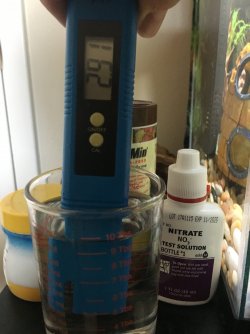Thank you. I think I'll have to travel around as where I live there is only one lfs and this doesn't have very much so I think I need to find a specialist in the SE England.I prefer the larger true floaters. Small plants like duckweed can be useful at removing organics/nutrients/ammonia, but they can be rather a nuisance in many tanks and have no "substance" to speak of. A slightly larger but still small floating plant is Salvinia; S. natans is sometimes seen, this is a bit smaller than the truly lovely S. molesta which is probably the correct name for the larger species though it may be seen as S. auriculata that will be the same. Salvinia is a small floating fern, the sole genus in the Salviniaceae family. It consists of three leaves, two floating and one modified leaf submerged that may be mistaken for a root; the stem is branching and creeping, bearing hairs but no true roots. The larger S. molesta has a beautiful silvery sage green sheen to the leaves.
Moving on to more substantial plants, Ceratopteris cornuta (Water Sprite) is probably the nicest. This is also a fern, and there are three species, with C. cornuta being the best floating. This plant will spread its fronds (leaves) to cover the surface of any aquarium if allowed to; daughter plants are produced rapidly on alternate fronds so it is easy enough to remove these as new plants during a water change and discard the larger parent plant. I've been doing this for more than 20 years now, all from a single purchased plant, and I have this plant in three or four tanks. Not always easy to find, but well worth it.
Frogbit is another good floater; there are two temperate species that do not do as well in the aquarium as the true tropical species, Limnobium laevigatum, that comes from South America. I bought a very poor decrepit plant that was labelled the Amazon Frogbit some years ago, and it turned out to be one of the temperate species, identified when it flowered shortly thereafter. It has managed in a couple tanks since, though not as well as I expect the true tropical species would, with the continuing heat.
Another similar is Water Lettuce, Pistia stratiotes. Sometimes one sees a "dwarf water lettuce" but this is only small plants of the species, as there is only the one. Interesting roots when it is happy; I have them extending right down to the substrate in a 20g tank.
Some stem plants make good floaters, Brazilian Pennywort (Hydrocotyle leucocephala) being my particular favourite.
Byron.
Sent from my SM-G930F using Tapatalk



 ?
?